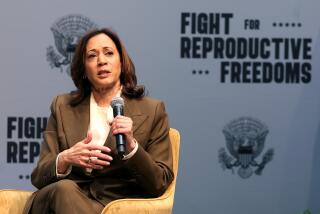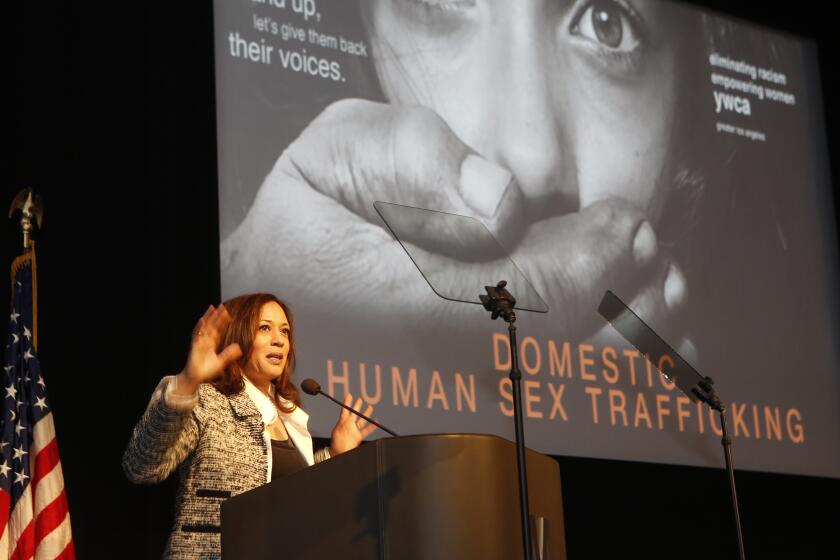As Roe vs. Wade Turns 30, Rulingâs Future Is Unsure
WASHINGTON â WASHINGTON -- The Roe vs. Wade ruling that legalized abortion nationwide turns 30 this week, but its prospects for the future look none too secure.
Only five of the nine U.S. Supreme Court justices strongly support the abortion right, and two of them -- 82-year-old John Paul Stevens and 72-year-old Sandra Day OâConnor -- are likely to retire within a few years.
President Bush ran on a platform that promises he will appoint judges who ârespect the sanctity of innocent human life.â
And if Bush is reelected, he will almost surely choose the successors for Stevens and OâConnor, as well as Chief Justice William H. Rehnquist.
The prospect alarms advocates for abortion rights.
âRoe is in grave peril,â says Betsy Cavendish, legal director for NARAL Pro-Choice America, formerly known as the National Abortion and Reproductive Rights Action League. âA switch in one vote [at the high court] could ban some abortion procedures and possibly ban second-trimester abortions. With a switch in two justices, Roe could be overturned entirely.â
Justice Anthony M. Kennedy, a 66-year-old appointee of President Reagan, remains something of a question mark.
In 1989, he signed on to Rehnquistâs opinion in a Missouri case that looked to be a precursor to overturning Roe vs. Wade.
Two years later, the retirement of liberal Justice Thurgood Marshall and his replacement with conservative Justice Clarence Thomas gave lawyers for the first Bush administration good reason to believe they had a Supreme Court majority to overturn Roe.
But when the issue was tested in a Pennsylvania case, Kennedy switched sides and cast the crucial vote to preserve the basic right to abortion. The 5-4 majority said that states could regulate abortion, but that women retained the right to choose abortion prior to the time when the fetus is âviable,â which doctors have said occurs about the 23rd week of pregnancy.
That surprise ruling in 1992 came as a stunning setback for the antiabortion movement. All five justices who voted to affirm the abortion right were Republican appointees. And the three authors of the courtâs main opinion -- Justices OâConnor, Kennedy and David H. Souter -- were Reagan or Bush appointees.
A few months later, Democrat Bill Clinton was elected president, and he was committed to appointing justices who would support abortion rights.
In 1993, he chose Ruth Bader Ginsburg, a renowned womenâs rights advocate, to succeed the retiring Justice Byron White, a conservative who wanted the Roe ruling overturned. And in 1994, when Justice Harry Blackmun, the author of the Roe opinion, retired, Clinton replaced him with Justice Stephen G. Breyer, a solid abortion-rights supporter.
Those moves formed a 6-3 majority in favor of abortion rights, with Justices Rehnquist, Thomas and Antonin Scalia opposed.
But recently, the tide has begun flowing in the opposite direction.
Three years ago, Kennedy delivered an angry dissent when the court, on a 5-4 vote, struck down a Nebraska ban on a procedure that abortion foes labeled âpartial-birthâ abortion.
Most physicians consider this term inflammatory and misleading. It describes a procedure by which doctors, so as to prevent bleeding, remove a midterm fetus intact, rather than in pieces.
Kennedy called these abortions âabhorrentâ and accused OâConnor and Souter of having betrayed their 1992 joint opinion. Then, the three agreed that states could regulate abortion but could not put âan undue burdenâ on women seeking to end their pregnancies. In the Nebraska case in June 2000, Kennedy said the ban on removing a midterm fetus intact did not put an undue burden on women because other procedures were available. OâConnor and Souter said it did, because it forced the women to undergo more dangerous surgery.
These days, Kennedy is seen as likely to join a conservative majority that restricts the practice of abortion but is unlikely to vote to overturn the right to abortion entirely.
Thatâs why supporters of legal abortion say that replacing OâConnor or Stevens with a Bush appointee could restrict abortion rights, while replacing both of them could lead to overturning the right to choose.
âThereâs no question Roe will not survive a second Bush administration,â says Nancy Northup, president of the New-York-based Center for Reproductive Rights. âRight now, we confront the most dangerous situation we have faced. We have an anti-choice president, an anti-choice Senate, and the slimmest of majorities [at the court] in favor of Roe.â
Lawyers for abortion opponents say they are optimistic that Roe vs. Wade will be weakened but are not ready to predict it will be overturned. They remember the overly confident predictions from the late 1980s, when conservatives believed the abortion right was doomed.
âI donât take anything for granted. We still have a tremendous hurdle ahead,â says Jay Alan Sekulow, chief counsel for the American Center for Law and Justice, which is based in Virginia Beach, Va. âIt will take a significant shift for Roe to be put at risk.â
Sekulow says he is confident that Bush will appoint justices who share his conservative philosophy, but he noted that many conservatives are wary of overturning well-established legal precedents.
âOn the other hand, I think more people are coming to realize that Roe is like Dred Scott. Itâs a fundamentally flawed decision that cannot stand,â Sekulow said.
He referred to the infamous 1857 ruling that said former slaves had no rights, even in the âfree statesâ of the North. It took the Civil War to overturn the Dred Scott decision.
Catholic University Law Dean Douglas W. Kmiec also foresees more state restrictions on abortion, but not an overruling of the basic abortion right.
He said the 1992 decision in Planned Parenthood of Southeastern Pennsylvania vs. Casey set a framework that is likely to stand.
âIn law school textbooks, Roe is being replaced by Casey. It signals the states have a regulatory role to play,â said Kmiec, a former Pepperdine University law professor.
For example, more states are requiring teenage girls to have a parentâs permission before they obtain an abortion. Kmiec also believes a ban on certain midterm abortions will be upheld in the years ahead if Bush nominates justices to the court.
But these new justices, even conservative ones, would be reluctant to overturn a well-established precedent such as Roe, as OâConnor, Kennedy and Souter have shown, he said.
For that reason, Kmiec cannot foresee a reversal of Roe. âStates will have more latitude to forbid extreme procedures,â he said, but the right to choose abortion will stand.
More to Read
Get the L.A. Times Politics newsletter
Deeply reported insights into legislation, politics and policy from Sacramento, Washington and beyond. In your inbox three times per week.
You may occasionally receive promotional content from the Los Angeles Times.











